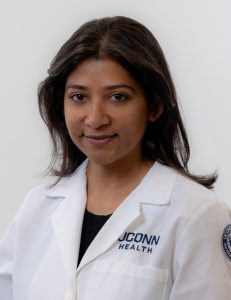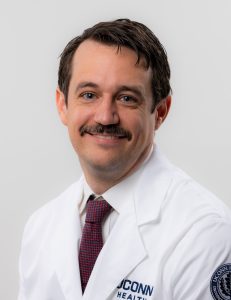Dr. Christopher Conner is now performing deep brain stimulation to treat the symptoms of Parkinson's disease at UConn Health.

Neurosurgeon Christopher Conner, MD. Ph.D. (center), and his surgical team (left to right: Bethany Bobinski, RN and resident Taylor Burch, MD) perform deep brain stimulation (DBS) surgery on March 15, 2024. (Tina Encarnacion/UConn Health Photo)
Dr. Christopher Conner, an assistant professor of Neurosurgery at UConn Health, is using deep brain stimulation (DBS) to treat the symptoms of Parkinson's disease.
Parkinson's disease is the second most common neurodegenerative disorder affecting the nervous system and parts of the body controlled by nerves in one million people in the U.S. It causes problems with movement, mental health, sleep, pain, and other health issues. Parkinson's disease gets worse over time, and there is no cure, but therapies and medicines can reduce symptoms.
This gradually progressive disease usually presents in those over the age of sixty with motor symptoms that include slowness, abnormal movements, and tremors. Depression, mood changes, anxiety, apathy, memory, and sleep issues are some other symptoms patients may experience. This disease is more prevalent in men, affecting them one and a half times more than women.

Dr. Neha Prakash, assistant professor of Neurology at the Parkinson's Disease and Movement Disorder Center at UConn Health, explains that people usually start to develop symptoms that affect their quality of life, and day-to-day activities begin to take longer to complete.
There is no cure, but treatment modalities are available to improve symptoms and quality of life.
"It is important for someone with Parkinson's to have the right team on their side. It's not just a neurologist, it takes a village, the team here at UConn Health, creates an environment that people feel empowered to participate in their care," says Prakash.
The mainstay is symptomatic treatment with medication and physical, speech or occupational therapy and supportive treatment. As the disease progresses the needs will change, and so treatment options will need to change as well.
For those who qualify and make a good candidate, deep brain stimulation could be an option.
DBS is very similar to a pacemaker that one would have for their heart. With DBS wires and a battery are placed in the body to stimulate the brain.

"The best thing overall is treatment with medication-, however for the right candidate DBS can be a life altering event. Usually by the time a patient is ready for DBS, they have been treated by a movement disorder neurologist for several years," says Conner. "The decision to have the surgery depends on how fast the patient is progressing and how much benefit they would get out of it. The surgery is something that many patients with Parkinson's look forward to as they progress and can transform their life. It's an incredible thing, and if medications are no longer giving the benefit they need, it's the best option.
A patient is considered a good candidate if they have had a Parkinson's diagnosis for five years. They must still be responsive with medical therapy, most patients are relatively well treated with just oral medication, over time the patient is going to need more medications which is a reason to think of DBS. It is brain surgery, a life event for the patient and they must be healthy enough to go through a relatively complicated surgery.
The first step of the surgery is to drill two holes into the head and place two wires about six centimeters into the brain where they are chronically and continuously providing electrode stimulation to treat the symptoms that patient has.
During the first surgery the patient is partially awake so that testing in the operating room can take place to make sure that the wires are where we want them in the brain. The vast majority of patients go home the next day.
The act of placing the wire into the brain will cause some swelling and edema in the brain and patients actually feel like they are getting the effect. This is called the honeymoon period and lasts a couple of weeks where patients will see a vast improvement in the symptoms, but that fades with time.
The second surgery takes place about two weeks later when a battery is placed in the patient, and they can go home the same day.
Several weeks are allowed after the battery is implanted to allow the healing process to occur before the patient sees a movement disorder neurologist and the programming starts. Currents are run to the brain, and it takes a little while to get to optimum level.
"It's like setting a thermostat and finding the right amount of stimulation that works for that patient's brain. It can take four to six weeks of programming sessions to get to the right level. Patients will see the most benefit by three months," says Conner.
Conner is excited about the DBS program and the effects it has on many diseases. He also treats patients with epilepsy, and it can also be used to treat dystonia in the pediatric population. There are currently trials researching the use for psychiatric disorders such as depression and a study he was involved in on use for fentanyl addiction.
"The therapy is getting more effective over time, the equipment and hardware are getting better, as well as the way the programming is done and the diseases we can treat are expanding so it's a really exciting time for DBS," says Conner. "I can see over the next 10-20 years we are going to be able to treat many diseases that until now have been very difficult to treat and this is what excites me about being a neurosurgeon, being able to offer this treatment to patients who have not had a lot of options.
"The addition of this surgical option to the world class expertise in our movement disorders center is consistent with the promise of our Brain and Spine Institute that we will provide care second to none as we also shape the future of these treatment options" says Dr. Ketan Bulsara, chief of the UConn Health Division of Neurosurgery.
The Parkinson's Disease and Movement Disorders Center at UConn Health provides multidisciplinary, patient-centered care for people living with Parkinson's disease and other neurodegenerative disorders and can be reached at 860-679-4888.






